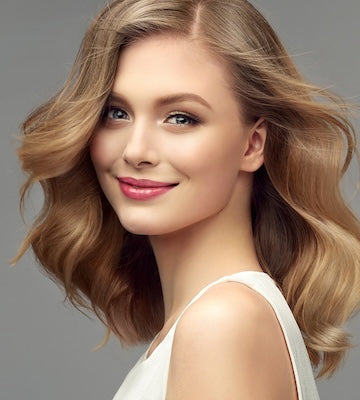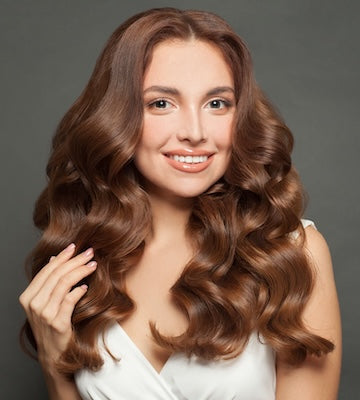Triggers and regrowth tips
Hair loss is an emotional journey, but it’s also a manageable one. By understanding the causes, exploring solutions and being kind to yourself, you can take steps toward healthier, stronger hair - and renewed confidence.
Hair plays a big role in how we see ourselves. It’s not just about looks. It’s tied to confidence, identity and even how we express our personality. So, when you start noticing more strands in your brush or hair falling out in the shower, it’s natural to feel concerned.
The truth is, some hair loss is normal. Your hair naturally goes through a growth-shed-regrow cycle. But when there’s excessive hair shedding or bald spots on your head, it’s worth understanding what’s going on. The causes range from hormonal changes to stress, genetics, illness and nutritional deficiencies. But here’s the reassuring part: once you understand the “why,” you can find solutions that work for you.
In this article, we’ll explore the science behind female hair loss, break down some common causes and practical tips for preventing hair loss while supporting regrowth.
How much hair loss is normal?
Let’s start with an important fact: shedding some hair every day is completely normal. On average, women lose about 50 to 100 hairs daily, and this can increase if you’ve been brushing, styling or washing your hair more vigorously than usual.
Hair grows in cycles:
-
Anagen phase (growth phase): Around 85-90% of your hair is in this phase at any given time, lasting 2-7 years
-
Catagen phase (transition phase): This is when hair follicles shrink and growth slows, lasting about 10 days
- Telogen phase (resting phase: Around 10-15% of your hair is in this phase, lasting 2-3 months before shedding to make way for new hair
It’s only when you notice persistent excessive shedding or visible thinning - like a wider parting, receding hairline or patchy hair loss - that it may signal an underlying issue.
What causes female hair loss?
Hair loss in women (or “female alopecia”) can occur for a variety of reasons, and in many cases, it’s a combination of factors. Some common causes include genetic predisposition, hormonal imbalances, dietary deficiencies or external stressors. And while it’s completely normal to shed some hair, there’s a difference between daily shedding and excessive hair loss indicating an underlying issue.
There are many ways to support your hair’s health and encourage regrowth - but it’s important to remember that patience is key. Hair grows slowly (around a centimetre a month on average), so focusing on what you can control and taking small, consistent steps is key.
1. Genetics: the role of female pattern baldness
If hair loss runs in your family, there’s a chance genetics are at play. Female pattern baldness, or androgenic alopecia, is the most common cause of hair loss in women. Hair loss happens when hair follicles shrink due to genetic sensitivity to androgens (male hormones like testosterone), causing hair to thin over time.
Unlike male pattern baldness, which leads to receding hairlines or bald spots, androgenic alopecia in females usually causes a widening parting or thinning crown.
Hair extensions tailored to the crown can help your confidence. But if women in your family have experienced noticeable thinning, it’s worth discussing this with a healthcare professional. Hair regrowth treatments (for instance, minoxidil) can slow the progression.
2. Hormonal imbalances and life stages
Hormones play a huge role in regulating the hair growth cycle. When they shift, they can throw things out of balance.
As a result, hormones are often the biggest culprit behind female hair loss. Fluctuations caused by pregnancy, menopause, thyroid issues, or conditions like PCOS (polycystic ovary syndrome) significantly impact the hair growth cycle.
-
Postpartum Hair Loss: Pregnancy hormones keep hair in the growth phase longer, so your hair may feel thicker during pregnancy. After birth, when hormone levels drop, that extra hair sheds. While postpartum hair loss can feel dramatic, it’s temporary and usually resolves within a year
-
Menopausal hair loss: As oestrogen and progesterone levels decline during menopause, hair can become thinner and more brittle. These hormonal changes may also increase the effects of androgens, leading to menopause hair loss on the scalp and sometimes excess facial hair
-
Thyroid issues: Both underactive (hypothyroidism) and overactive (hyperthyroidism) thyroid glands can disrupt the hair cycle, causing hair to thin or shed. Other symptoms include fatigue, weight changes and brittle nails
-
Polycystic Ovary Syndrome (PCOS): High levels of androgens in women with PCOS can cause hair thinning on the scalp. As well as PCOS hair loss, this can result in increased hair growth in less desirable places, like the face or body
- Ageing: It’s natural for hair to thin with age, just like our skin loses elasticity. Over the years, our hair follicles produce thinner, more fragile strands, and some may stop producing hair altogether
If you’re experiencing hormonal hair loss (especially during and after menopause), it’s worth exploring options like hormone replacement therapy (HRT) with your doctor. While it isn’t right for everyone, HRT can be a game-changer for many women.
3. Losing hair from stress: telogen effluvium hair loss
Stress doesn’t just affect your mind - it impacts your hair too. Emotional or physical stress (like illness, surgery, or significant life changes) can cause telogen effluvium, a condition where a larger percentage of hair follicles enter the resting phase and shed prematurely.
The effects of stress-related hair loss often show up a few months after the stressor, making it harder to connect the dots. But the good news is once stress is under control, your hair growth cycle usually returns to normal.
To fix hair loss due to stress, relaxation is crucial. Whether it’s yoga, meditation or simply taking a peaceful walk in nature, make time for activities that calm your mind. If you’re feeling overwhelmed, talking things through with someone - a friend, partner or even a therapist - can ease the emotional weight.

4. Nutritional deficiencies
Your hair relies on a steady supply of nutrients to stay healthy and strong. Without the right building blocks, it’s harder for your hair to thrive. If you’re wondering which vitamin deficiencies cause hair loss, key nutrients to focus on (either via your diet or additional supplements) include:
-
Iron: Low iron levels (common in women with heavy periods) can lead to hair thinning, as your scalp may not get enough oxygen-rich blood to nourish follicles
-
Vitamin D: Vital for follicle health, a deficiency can weaken hair over time
- Protein: Hair is made of keratin, a protein. Without enough protein, your hair might become brittle and shed more easily
The solution? Your hair reflects your overall health, so caring for your body is a great place to start. A diet rich in iron, protein, and essential vitamins (like Vitamin D, C and biotin) can do wonders for your hair. Think leafy greens, eggs, nuts and oily fish. And don’t forget hydration - drinking plenty of water helps keep your scalp healthy and your strands strong.
5. Medications and medical treatments
Sometimes, the medications we rely on to feel better or manage conditions can have unexpected side effects, including hair loss. Certain antidepressants, birth control pills, blood thinners, and even some acne treatments may cause hair to thin or shed. Chemotherapy drugs, as many know, have an extreme effect, causing temporary but significant hair loss as they target rapidly dividing cells, including those in hair follicles.
If you’ve recently started a new medication and noticed changes in your hair, it’s worth discussing this with your doctor. They can help determine if medication might be the culprit and explore alternative options or ways to minimise its impact on your hair. This type of hair loss often resolves once medication is stopped or adjusted - so don’t hesitate to advocate for yourself.
6. Tight hairstyles and heat damage
Tight ponytails, braids or buns can all pull on your scalp and weaken hair at the root. Over time, this constant tension can cause traction alopecia, where the hair stops growing back altogether in affected areas.
Blow dryers, curling irons and straighteners can also dry out and damage your strands. Add harsh chemical treatments like perms or bleach to the mix, and your hair might need a break.
If you suspect your heat styling habits are taking a toll, try switching to gentler alternatives. Opt for looser hairstyles, use heat-protectant sprays, or embrace natural drying whenever possible. Microfibre towels and satin scrunchies can also reduce any unnecessary damage.
7. Autoimmune hair loss: alopecia areata
Autoimmune disorders like alopecia areata are another factor that can contribute to hair loss. In these cases, your immune system mistakenly targets your hair follicles, causing them to shrink or stop producing hair altogether. This condition often leads to patchy hair loss, and while it can be emotionally challenging, it’s more common than you might think.
There are treatments to help manage the condition, from corticosteroid injections to topical immunotherapy. If you think autoimmune issues might be behind your hair loss, a dermatologist can help confirm the diagnosis and guide you toward the best treatment options.
8. Scalp health: the foundation for stronger hair
If your scalp isn’t getting the care it needs, it could contribute to hair thinning. Common scalp issues like dandruff, psoriasis or excess oil production can clog hair follicles and weaken strands at the root.
To promote a healthier scalp, regular scalp massages are a simple yet effective solution. Massaging your scalp not only feels relaxing but promotes blood circulation to your hair follicles, delivering the nutrients and oxygen needed for stronger strands. For an added boost, try incorporating natural oils like coconut, argan, olive or castor oil into your massage routine. These oils can nourish the scalp, reduce dryness and create a supportive environment for hair growth.
For persistent scalp concerns, such as itchiness, inflammation or flakiness, consulting a professional is always a good idea. A dermatologist or trichologist (a specialist in hair and scalp health) can pinpoint the cause of your hair loss and recommend treatments such as medicated shampoos or topical solutions.
Coping with hair loss: finding strength and confidence
Female hair loss is a deeply personal experience that affects so many women. One of the most powerful steps is approaching the situation with patience and self-compassion.
Give yourself permission to feel what you’re feeling, whether it’s frustration, sadness or even anger. Sharing your thoughts with someone you trust - whether that’s a close friend, family member or support group - can be incredibly comforting. You’d be surprised how many people have similar stories.
If the emotions are too heavy to manage on your own, speaking with a therapist can help you work through them in a safe, supportive space. A good therapist can guide you in finding a fresh perspective and focusing on the things that make you feel confident and strong - like your relationships, achievements or even your personal style.
While you’re giving your hair time to regrow, hair extensions can be wonderful for boosting your confidence. Our range of luxurious, Virgin human hair extensions are designed to blend seamlessly with your natural hair. They’re perfect for adding instant volume and length discretely while you work on regrowth, helping you feel your best every step of the way.










